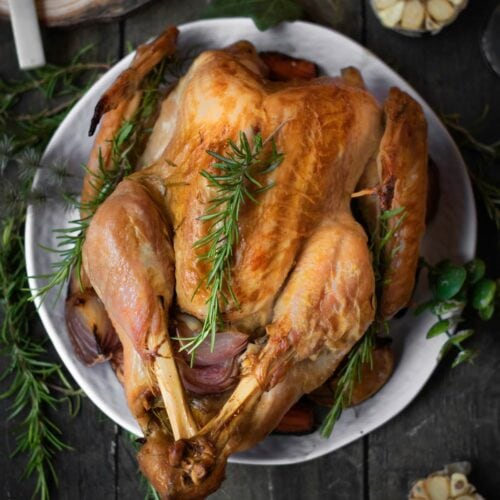
Roasted Turkey Made Easy and Stress-Free
A perfectly roasted turkey is the ultimate holiday centerpiece, and this recipe makes it easier than ever to get it just right. With crispy, golden skin, tender and juicy meat, and flavors of butter, garlic, fresh herbs, and a bright touch of lemon, this turkey is as delicious as it is stunning. If it’s your first time roasting a turkey, don’t worry—this step-by-step recipe is foolproof and designed to help you succeed, stress-free!
Ingredients
- 1 whole turkey about 18 pounds, neck and giblets removed
- 1 ½ cups sea salt
- ½ cup brown sugar
- 4 quarts cold water
- ½ cup unsalted butter melted, divided
- 2 large onions chopped, divided
- 4 medium carrots coarsely chopped, divided
- 4 stalks celery chopped, divided
- 3 sprigs fresh rosemary divided
- 1 whole lemon quartered
- 1 head garlic halved horizontally
- 1 bay leaf
- 1 cup dry white wine
- 1 pinch ground black pepper to taste
Instructions
- Start by mixing sea salt, brown sugar, and cold water in a large stockpot and stir until fully dissolved. Submerge your turkey in the brine solution, cover, and refrigerate for 12 hours or overnight.
- Preheat your oven to 350 °F. Take the turkey out of the brine, rinse it thoroughly under cold water, and pat it dry with paper towel. Discard the brine.
- Brush the turkey, inside and out, with half of your melted butter, and sprinkle freshly ground black pepper into the cavity.
- Fill the turkey cavity with a chopped onion, carrots, celery, lemon quarters, a sprig of rosemary, and half a garlic head.
- Place the turkey breast-side down on a roasting rack in a shallow pan. Scatter the remaining veggies, rosemary, and a bay leaf in the pan. Pour dry white wine over the vegetables for extra aroma and flavor.
- Pop the turkey in the oven, uncovered, and let it roast for 3.5 to 4 hours.
- Around two-thirds of the way, carefully flip the turkey breast-side up and brush on the remaining melted butter. Your turkey is ready when the juices run clear, and a thermometer in the thickest part of the thigh reads 165 F (74 C).
- When the turkey is cooked, take it out of the oven and let it rest for 30 minutes before carving—this step is a must for juicy, flavorful meat. Arrange the carved turkey on a platter with the roasted veggies and enjoy!
Notes
- Allow one full day in the fridge for every 5 pounds of turkey. With brining and prep time in mind, it’s best to buy your turkey at least a week before serving to avoid last-minute stress.
- Skip washing the turkey. It might feel natural to rinse it, but washing poultry can spread bacteria to your countertops and other surfaces. Trust the roasting process—oven heat will safely kill any bacteria.
- Cook the stuffing on the side. For the best flavor and texture, bake your stuffing separately. Stuffing inside the bird takes longer to cook, which can dry out the turkey or leave the stuffing undercooked.
- If the turkey skin starts to brown too quickly, cover it loosely with foil. This keeps the skin from burning while letting the bird finish roasting perfectly.
- Let it rest. After roasting, loosely cover the turkey with foil and let it sit for at least 30 minutes. This helps the juices redistribute, making the meat juicier and easier to carve.
Nutrition
Calories: 123kcalCarbohydrates: 13gProtein: 1gFat: 7gSaturated Fat: 4gPolyunsaturated Fat: 0.3gMonounsaturated Fat: 2gTrans Fat: 0.3gCholesterol: 17mgSodium: 12166mgPotassium: 153mgFiber: 1gSugar: 10gVitamin A: 3168IUVitamin C: 4mgCalcium: 45mgIron: 0.4mg
Did you make this recipe?Please leave a review and share your experience with us! Your feedback means a lot to the entire community.